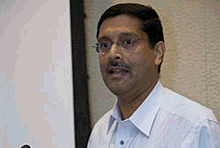
Typical street scene in Santa Ana, El Salvador. (Photo: iStock)
IMF Survey: How to Extend Latin America's Growth Spells
January 15, 2007
- Maintaining growth can be difficult
- Democratization during growth tends to prolong it
- Countries that liberalize trade tend to grow for longer.
Latin America may be in its third year of economic recovery with reasonable prospects for next year, but that is not quite enough to banish the ghosts of decades of starts and stops.
Workshop on Economic Growth and Latin America
The workshop on growth in Latin America and the Caribbean featured four sessions on: (i) the frontiers of empirical growth research; (ii) the obstacles to growth in low-income countries; (iii) the growth performance among middle-income, emerging market economies; and (iv) a panel discussion.
The papers, presentations, and discussions from the workshop can be found here.
Latin America workshop
Against the backdrop of current growth, the IMF's Western Hemisphere Department convened a day-long conference to examine the recent research of IMF economists and outside specialists on the issue of economic growth—perhaps the most important factor in poverty reduction—and the outlook for continued expansion in Latin American and Caribbean countries.
Two issues in broader growth theory provided a basis for the day's discussions: the role of foreign capital in the economic growth of developing countries and how to make growth spells last longer. Standard economic models suggest that capital should flow from rich countries to poorer countries because the investment opportunities are more productive in countries that have a low capital-to-labor ratio. But the IMF's Arvind Subramanian said that, increasingly, capital is flowing from poorer to richer ones. Moreover, poor countries that ran current account surpluses, not relying on foreign financing, have tended to grow faster than countries that ran current account deficits.

Jeromin Zettelmeyer (Photo: Eugene Salazar/IMF)
There are several potential explanations, Subramanian said. Research that he and IMF colleagues Eswar Prasad and Raghuram Rajan did in their paper "Foreign Capital and Economic Growth" found that external capital may not be needed in countries that generate more domestic savings than can be put to productive use. Or foreign capital may not help in countries that do not have the capacity to absorb it. In some instances, foreign capital could be helpful, but financial systems are insufficiently developed to harness it. He said that foreign direct investment (which often does not rely on the domestic financial system) tends to behave more in line with the standard model.
There is, he added, a less benign reason for lower inflows of foreign capital: it can hurt development. Countries may avoid capital inflows because they lead to overvalued currencies, which, in turn, hurt competitiveness in key sectors, such as manufacturing.
Starting and stopping
When it comes to growth, many developing countries, including those in Latin America, have historically not had trouble getting it started. The problem has been an inability to maintain the type of "long-sustained growth spells that have been the basis of prosperity in Asia" and that are typical of industrial countries, according to the IMF's Jeromin Zettelmeyer.

Arvind Subramanian (Photo: Eugene Salazar/IMF)
Zettelmeyer and his coauthors Andy Berg and Jonathan Ostry, in "What Makes Growth Sustained," analyzed the experiences of 140 countries to determine how initial conditions and developments during a growth spell affected its duration. The cross-country analysis found that the most potent variable was the level of inequality in a society. The more unequal the income distribution, the worse the country's chances of sustaining a long growth spell. The analysis also found that, although the initial level of democracy did not help predict the length of a growth spell, democratization during the spell tended to prolong its life. Furthermore, countries that liberalized trade have tended to enjoy longer growth spells. Although not as robust a predictor, export-oriented growth lasted longer, perhaps because export sectors create their own constituencies for institutional reform. The most important external threat to a sustained recovery is the volatility of U.S. interest rates.
The IMF's Rishi Goyal also found that U.S. interest rates are the only external shocks significantly related to the large ups and downs that have characterized Latin American economic performance. In the IMF Working Paper "Volatility and Growth in Latin America: An Episodic Approach," he and coauthor Ratna Sahay studied 17 countries and found that U.S. interest rates "were nearly twice as high" during periods of low growth. They also found that volatile fiscal policies, low levels of market-oriented reforms, and the reversal of previously implemented reforms were associated with lower growth.
Presentations on Argentina, Brazil, Mexico, and Peru found grounds to be hopeful that growth would continue. And one presentation suggested that in Brazil, at least, growth is far higher than what is being reported.
Will Argentina's growth endure?
Few Latin American countries historically have had a more volatile economic performance than South America's second-largest country. But since the crisis of 2001-02, when output plunged and poverty and unemployment rose dramatically, Argentina has mounted a steady recovery. Output has risen 36 percent since then, and unemployment and poverty have fallen.
"The government gets credit because it has sustained unprecedented, good macroeconomic policies," Harvard University professor Federico Sturznegger said. The government is running a strong fiscal surplus, restructuring debt, and maintaining an undervalued currency (which encourages savings). It has also resorted to price controls, but these, he said, have been ineffective. Can recovery be sustained? Probably, he said. A combination of the good macroeconomic policies and reforms undertaken in the 1990s to open up the economy will enable the country to make the transition to a lower but still high rate of growth "without a new macro crisis." For Argentina, said Sturznegger—a government economic official during the 2001 crisis—"that is a first."
Brazil, the region's biggest economy, has had—like most Latin American countries—a lackluster growth performance since 1980. But the IMF's Martin Cerisola and coauthors Ricardo Adrogué and Gaston Gelos said that changes in economic policies since the mid-1990s have helped raise the annual growth rate to about 2.75 percent in recent years—better than in the 1980s and 1990s, but substantially below that in the 1960s and 1970s.
Those reforms included privatization, deregulation, and sharp tariff cuts. All led to a more open economy and increased competition, and helped raise productivity. In the IMF Working Paper "Brazil's Long-Term Growth Performance—Trying to Explain the Puzzle," Cerisola said that prospects for continued growth are good.
Is growth underestimated?
One controversial presentation suggested that there may be no need to explain Brazil's recent low growth because it has been growing far faster than published data indicate. The IMF's Irineu de Carvalho said that Brazil's consumer price index seriously overstated inflation after the country had liberalized its trade regime, because the index failed to take account of new goods or of rapid quality improvements in existing goods. As a result, de Carvalho said—in a presentation based on "The Myth of Post-Reform Income Stagnation in Brazil," coauthored with the IMF's Marcos Chamon—real income growth may be understated by as much as 3 percentage points a year when the index is used to deflate nominal growth figures. He said similar biases may occur in other Latin American countries, but he found the understatement in Mexico was much smaller, on the order of 1.4 percentage points a year.
The Mexican economy has been growing at about 3-4 percent a year since 2003 and has put in place a number of reforms over the past two decades. Its performance has been good relative to other Latin American economies, according to a presentation by the IMF's Vincent Moissinac, but not as good as that of Asian countries. He said that further reforms are needed, especially if Mexico is to position itself to deal with future shocks, such as increased competition from China.
Peru also suffered in the 1980s and early 1990s, but stabilized its economy and initiated structural reforms in the mid-1990s. On average, real GDP has grown at about 2.5 percent a year for the past decade and a half, although real GDP is only now approaching its 1975 peak, and about half the population remains under the poverty line.
The IMF's Eva Jenker, in a presentation based on "Growth and Reform in Peru Post-1990: A Success Story," said that Peru needs to expand education and infrastructure while continuing stable monetary and fiscal policies. Further structural reforms are also needed to make labor markets less rigid. She called for more research on how to strengthen the link between economic growth, which is improving, and the reduction of poverty, which remains high.







